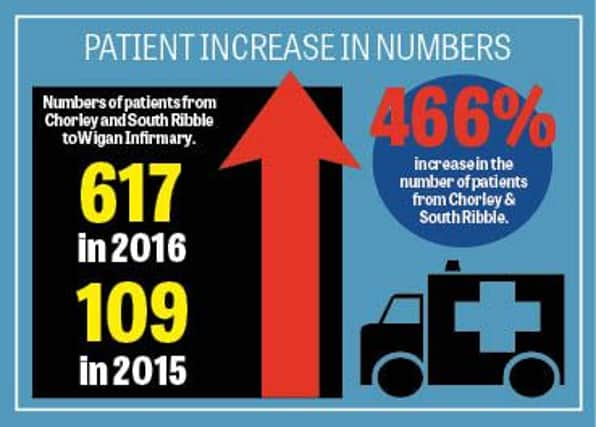Wigan sees huge rise in patients from Chorley A&E


There was a staggering 466 per cent increase in the number of patients from Chorley and South Ribble taken to Wigan’s A&E unit.
The ambulance service took 617 people from those areas to Wigan between April and December, when the department at Chorley was closed due to staffing problems.
Advertisement
Hide AdAdvertisement
Hide AdThat compares to just 109 patients in the same period in 2015.
Patients needing emergency care had to go to other hospitals when Chorley Hospital’s A&E unit shut in April.
At the time, hospital bosses in Wigan said they were “not anticipating a significant impact” on A&E.
But by June the Post reported there had been a four-fold rise in the number of people attending with a Chorley post code.
Advertisement
Hide AdAdvertisement
Hide AdChorley’s A&E partially reopened in January, providing emergency care for 12 hours a day.
The data, prepared for a recent meeting of NHS Wigan Borough Clinical Commissioning Group (CCG), reveals there were a total of 20,623 ambulance arrivals at Wigan between April and December. That was a 2.5 per cent rise on the 20,107 patients in 2015.
Of those, 2,223 were from outside the Wigan borough in 2015, increasing by 27.75 per cent to 2,840 last year.
As well as Chorley and South Ribble, there was a 19.76 per cent rise in the number of people form West Lancashire - from 764 to 915.
Advertisement
Hide AdAdvertisement
Hide AdThere were also more people from St Helens and Bolton, but fewer from the Wigan borough and other areas.
For the whole of 2016, there were 3,592 ambulance arrivals from outside the borough. This included 1,187 from West Lancashire, 701 from St Helens and 660 from Chorley and South Ribble.
Karen Partington, chief executive of Lancashire Teaching Hospitals NHS Foundation Trust, said: “In April 2016 we were no longer able to safely staff the emergency department at Chorley Hospital due to the national shortage of middle grade doctors, so we worked with surrounding hospitals and ambulance service to implement contingency plans to maintain safe and effective emergency and urgent care services for the local community.
“During this period the majority of patients who would have been taken to Chorley Hospital by ambulance previously were conveyed to Royal Preston Hospital, and a number taken to Royal Albert Edward Infirmary, as the nearest appropriate emergency department.
Advertisement
Hide AdAdvertisement
Hide Ad“We appreciate the support of the Wrightington, Wigan and Leigh NHS Foundation Trust team, and of the other health organisations that also worked with us to ensure safe services were provided for all patients in the local area during this difficult period.
“The emergency department at Chorley has been reinstated for 12 hours a day, alongside a 24-hour urgent care service, and local patients are now accessing their local hospital.”
Wigan health chiefs say they will continue to work closely with other trusts to ensure local patients are not affected by changes to NHS services.
Rob Forster, deputy chief executive of Wrightington, Wigan and Leigh NHS Foundation Trust, said: “We will continue to work closely with Lancashire Teaching Hospitals, and other service providers, to deliver safe, effective and appropriate care for all our patients.”
Advertisement
Hide AdAdvertisement
Hide AdDr Tim Dalton, GP and chairman of NHS Wigan Borough Clinical Commissioning Group, added: “Following the temporary closure of Chorley A&E, we have seen an increasing number of patients being brought to Wigan A&E by ambulance from the Chorley and West Lancashire areas.
“We are only getting a small percentage of their patients as most of the patients are being taken to Preston.
“Chorley A&E re-opened in January and is seeing patients everyday 8am to 8pm. This should lead to a natural reduction in the number of Chorley and West Lancashire patients attending Wigan.”
A North West Ambulance Service spokesman said: “The increase in attendances from neighbouring areas at Wigan Hospital has increased the demand on the emergency department but overall ambulance attendance is down on the same time last year.
Advertisement
Hide AdAdvertisement
Hide Ad“This is because of collaborative working and ongoing engagement across the health economy to ensure patients are receiving the best care, in the right place for their presenting clinical condition, meaning we are taking less to hospital than ever before.”